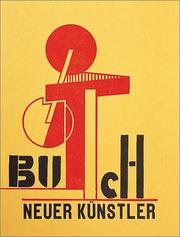| Listing 1 - 10 of 136 | << page >> |
Sort by
|
Book
Year: 1972 Publisher: Köln : Galerie Gmurzynska-Bargera,
Abstract | Keywords | Export | Availability | Bookmark
 Loading...
Loading...Choose an application
- Reference Manager
- EndNote
- RefWorks (Direct export to RefWorks)
Book
Year: 1962 Publisher: Amsterdam : Stedelijk museum,
Abstract | Keywords | Export | Availability | Bookmark
 Loading...
Loading...Choose an application
- Reference Manager
- EndNote
- RefWorks (Direct export to RefWorks)
Book
ISBN: 1527573915 9781527573918 152757184X 9781527571846 Year: 2021 Publisher: Newcastle-upon-Tyne, England : Cambridge Scholars Publishing,
Abstract | Keywords | Export | Availability | Bookmark
 Loading...
Loading...Choose an application
- Reference Manager
- EndNote
- RefWorks (Direct export to RefWorks)
Going beyond current readings of Concretism and Neoconcretism, this book shows how these movements were bred in the Brazilian circuit, after adapting international constructivism to the cultural conditions of the country. Thus, based on a systematic investigation in the archives of newspapers of that period, this book explores the premises through which Neoconcretism became organized and gained momentum in a series of debates between the avant-gardes of São Paulo and Rio de Janeiro--debates that focused on the visual arts and poetry as objects of intense aesthetic experimentation and prospective transformation. They offer a guide through what seems to be a maze of contradictory theories and purposes.Academic readers interested in Latin American and Brazilian art will learn about the contributions of Geraldo de Barros, Franz Weissmann, Ferreira Gullar, Lygia Clark, Luiz Sacilotto, Willys de Castro and Hélio Oiticica to Brazilian constructivism, and will realize that the seven chapters of this book inevitably question the canon of contemporary art. In fact, the contributions of these artists go beyond national borders, since Concretism and Neoconcretism created early versions of interdisciplinary and transdisciplinary art, participatory art, process art, visual poetry, performance, installation art, institutional critique, body art and environmental art, in some cases prior to the United States and Europe.
Book
Year: 1972 Publisher: Köln Galerie Gmurzynska-Bargera
Abstract | Keywords | Export | Availability | Bookmark
 Loading...
Loading...Choose an application
- Reference Manager
- EndNote
- RefWorks (Direct export to RefWorks)

ISBN: 3906700372 9783906700373 Year: 1991 Publisher: Baden Lars Müller
Abstract | Keywords | Export | Availability | Bookmark
 Loading...
Loading...Choose an application
- Reference Manager
- EndNote
- RefWorks (Direct export to RefWorks)
Constructivism (Art) --- Art, Modern --- Constructivism (Art). --- Art
Book
ISSN: 26127377 ISBN: 9788869762048 8869762041 Year: 2019 Volume: 15 Publisher: [Milano]: Mimesis,
Abstract | Keywords | Export | Availability | Bookmark
 Loading...
Loading...Choose an application
- Reference Manager
- EndNote
- RefWorks (Direct export to RefWorks)
La première partie de cet ouvrage comprend une édition critique de la conférence qu'Eisenstein prononça à l'exposition Film und Foto de Stuttgart, en 1929. La seconde définit le constructivisme tout en le situant dans son contexte politique et culturel, puis analyse les liens qu'Eisenstein a entretenu avec ce mouvement d'avant-garde. ©Electre 2020 En 1929, Eisenstein aurait dû prononcer une conférence lors de la grande exposition de cinéma et photo des avant-gardes internationales, à Stuttgart. Il y développe sa conception de l’art et du cinéma. Cet ouvrage propose une édition critique de ce texte fondamental : dans sa version initiale allemande et dans une traduction française inédite. Les variantes des différentes éditions et les notes additionnelles en russe sont également présentées. Dans sa deuxième partie l’ouvrage donne une définition du constructivisme au-delà du point de vue esthétique, en dessinant précisément le contexte culturel et politique de cette période. Sont enfin analysés les liens qu’Eisenstein a entretenu avec ce mouvement constructiviste – né dans les arts plastiques, étendu au théâtre et à la photographie, et enfin au cinéma.
Book
Year: 1977 Publisher: Eindhoven : Van Abbemuseum,
Abstract | Keywords | Export | Availability | Bookmark
 Loading...
Loading...Choose an application
- Reference Manager
- EndNote
- RefWorks (Direct export to RefWorks)
Book
Year: 1980 Publisher: Brussel : Ministerie van Nationale Opvoeding en Nederlandse Cultuur van België, Bestuur voor Internationale Culturele Betrekkingen, Dienst Kunstverspreiding,
Abstract | Keywords | Export | Availability | Bookmark
 Loading...
Loading...Choose an application
- Reference Manager
- EndNote
- RefWorks (Direct export to RefWorks)
Book
Year: 2008 Publisher: Berlin : Dom-verlag,
Abstract | Keywords | Export | Availability | Bookmark
 Loading...
Loading...Choose an application
- Reference Manager
- EndNote
- RefWorks (Direct export to RefWorks)
Book
Year: 1972 Publisher: Paris : Champ libre,
Abstract | Keywords | Export | Availability | Bookmark
 Loading...
Loading...Choose an application
- Reference Manager
- EndNote
- RefWorks (Direct export to RefWorks)
| Listing 1 - 10 of 136 | << page >> |
Sort by
|

 Search
Search Feedback
Feedback About UniCat
About UniCat  Help
Help News
News